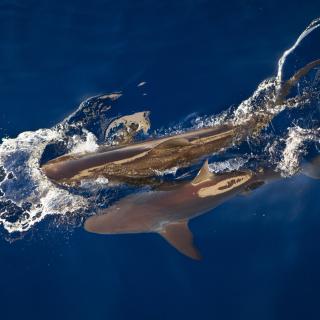Using Technology to Save Hawaiʻi's Sharks

As part of the first expedition of OET's expanded ocean exploration program, From Shore to the Abyss, in September 2022, a team of scientists, conservationists, and educators will be conducting research to quantify shark and ray diversity and relative abundance around Maui and the island of Hawai'i using low-impact and non-invasive research techniques. This expedition is made possible by a collaborative partnership between OET and National Geographic, resulting in a high-impact expedition that advances our discovery of multiple disciplines of oceanography, marine ecology, and conservation.
The shark team, led by Ariana Santos Agustines, will collect water samples for environmental DNA (eDNA) analysis and deploy baited remote underwater video systems (BRUVs) from small boats or while diving. They will then use an artificial intelligence (AI) image recognition tool to analyze retrieved footage, counting shark species in different habitats and documenting behavioral displays among species. By comparing data with previous studies, scientists can examine the effectiveness of Hawai'i House Bill 553, passed in January 2022, prohibiting sharks' capture, entanglement, and killing in state waters.
The research will utilize baited remote underwater video systems (BRUVs) and an artificial intelligence (AI) image recognition tool. Video footage from BRUVs will allow us to capture the presence and diversity of shark species, count their abundance in different habitat types, and document novel interaction or behavioral displays among species. The AI tool will assist in analyzing the recorded footage, maximizing efficiency in recognition and identification of shark species. Water samples will be taken for eDNA analysis to cross-analyze with BRUV footage and further assist in the presence of shark species. Lastly, outreach products will create learning opportunities about the Monument's environment and cultural significance for audiences worldwide.
Expedition participants will have the opportunity to participate in all aspects of the research activities, including the preparation and deployment of BRUV units through boat-based hand hauling methods and SCUBA, as well as the collection and processing of eDNA samples through similar processes. On board the ship, citizen scientists will help analyze the retrieved BRUV video footage through AI software, contributing to the expansion of repository shark images and continually training the algorithm for more accurate identification on a species level. There will also be opportunities to support the development of educational resources and engagement materials with the team's educators to highlight and promote sharks' cultural significance and ecological importance to garner support for their protection worldwide.
This research can provide a comparative analysis with previous studies conducted before the establishment of the protective legislation to determine the trends and status of shark populations. Improving our understanding of shark assemblages and habitat use within the Hawaiian Islands and filling knowledge gaps in our understanding of how legislation and management strategies affect shark diversity and abundance is crucial to ensuring sharks receive adequate and appropriate protection in their respective habitat ranges. Our research can provide data that can be used as a template and roadmap for other coastal communities, states, and nations to develop similar conservation measures for sharks in their respective regions.
An additional part of the work is creating multidisciplinary educational resources and outreach products that advance shark conservation by integrating traditional knowledge, scientific tools, and technology. The shark teamʻs project strives to contribute to the growing body of work integrating indigenous knowledge and research practices. To learn more and access resources, visit www.malamamanoproject.org
Join us as we venture into the shallows for our brand-new From Shore to the Abyss Program!
Launching in 2022, the From Shore to the Abyss Program expands OET’s ocean exploration program from the deep sea into coastal coral ecosystems lending our ship and research experience to contribute to new discoveries focused on the conservation of reefs and the generation of new knowledge. The program in 2022 will focus on the main Hawaiian Islands hosting a variety of teams leading research projects to gain a better understanding of the resident sharks and marine mammals, the impact of plastics on marine environments, and the maritime history of Hawai’i. This expedition is funded by the National Geographic Society.

From Shore to the Abyss: Exploration of Marine Mammal Communication and Shark Communities in the Main Hawaiian Islands
In our first leg of the brand-new expedition series From Shore to the Abyss, we are teaming up with (and receiving funding from) the National Geographic Society to study shallow waters near Maui and Hawaiʻi island. Project teams on this leg will combine cutting-edge technologies with indigenous Hawaiian knowledge to increase knowledge and understanding of marine life. The work will focus on sharks and marine mammals—apex predators who are culturally significant to the Hawaiian people.

From Shore To the Abyss: Exploration of Shark Communities and Microplastic Pollution in the Main Hawaiian Islands
In our second leg of the From Shore to the Abyss program, OET and National Geographic Society are exploring the waters of Maui and Hawaiʻi island while studying sharks and microplastic pollution investigating the intersection of humans and the ocean environment to inform policy and management of this ecosystem.



